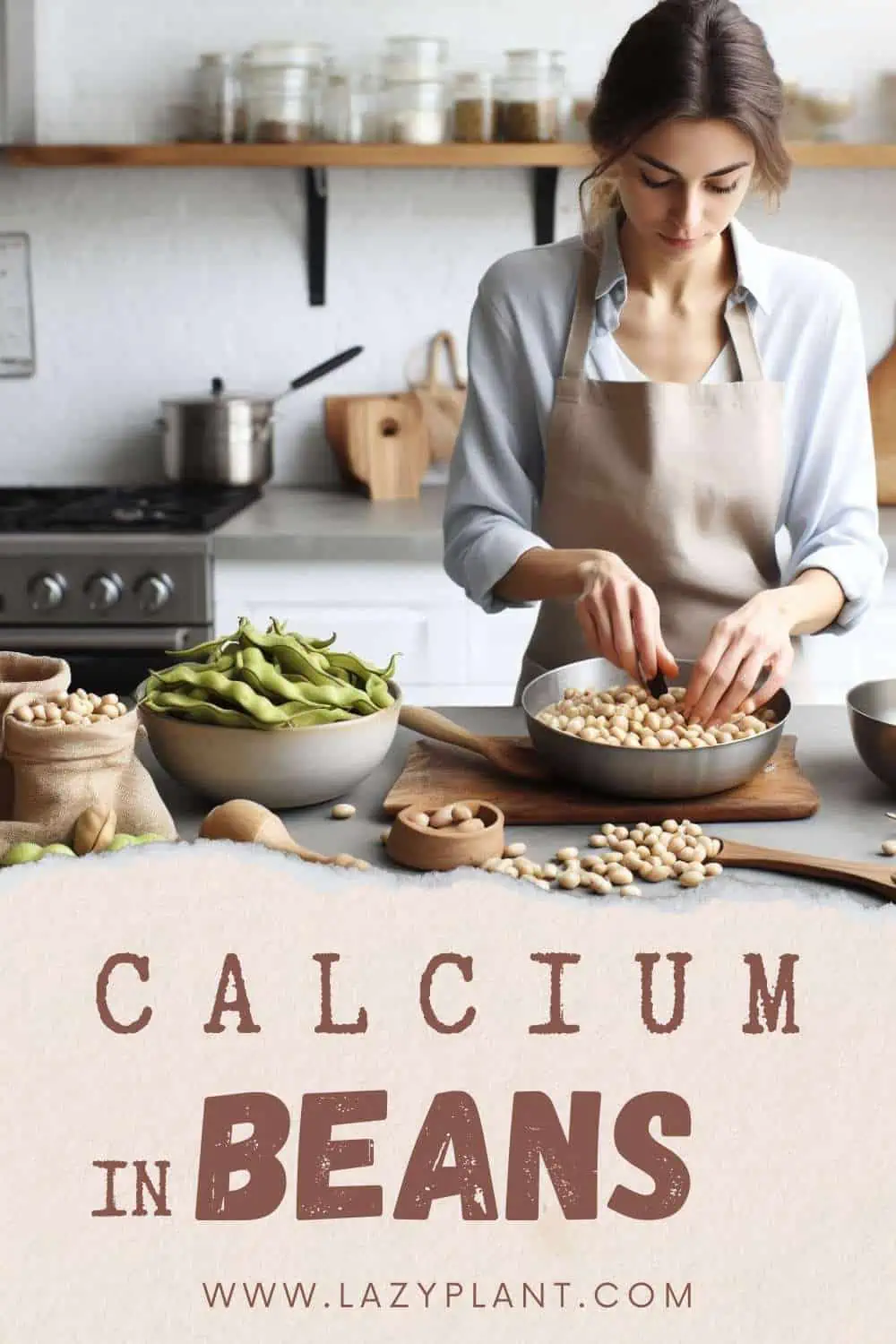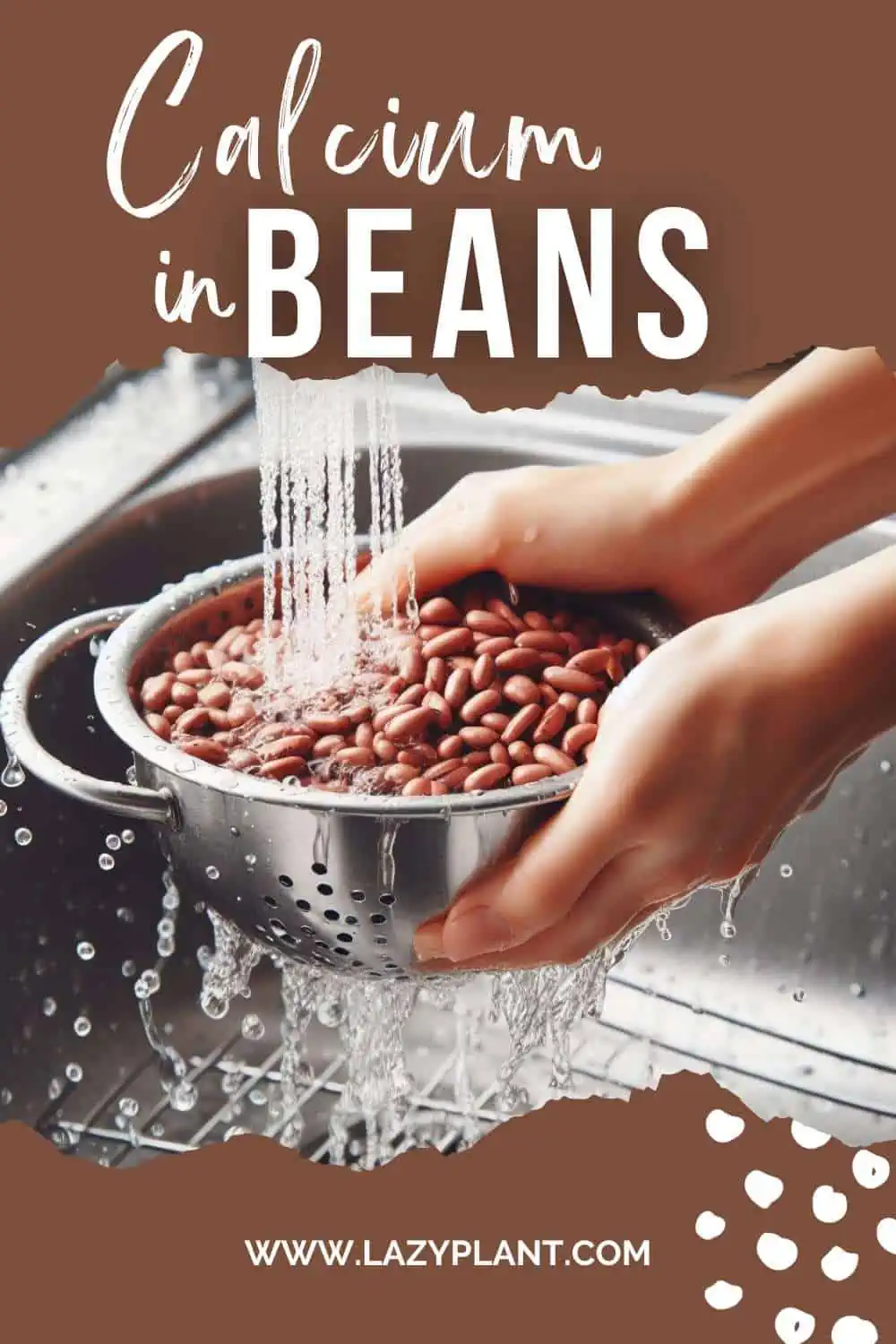Beans are excellent dietary sources of calcium. A serving contains up to 175 mg of calcium, or 18% of the recommended daily intake!
Health benefits of calcium
Calcium is the most abundant mineral in the body! It’s necessary for strong bones and teeth. Calcium deficiency may lead to osteoporosis.
In addition, calcium is involved in muscle movement and flexibility, blood vessel contraction and dilation, blood clotting, nerve transmission, and hormonal secretion.
Getting enough calcium may lower the risk of developing cardiovascular disease, hypertension, stroke, atherosclerosis, and even certain cancers.[1,2]

How much calcium do we need per day?
The recommended daily intake of calcium is 1,000 mg for adults.
Only women older than 50 years should get at least 1,200 mg of calcium a day, due to the increased risk of osteoporosis. Calcium absorption declines with age.
Moreover, children older than 13 years and teenagers require at least 1,300 mg of calcium a day, due to rapid bone growth.
What’s the calcium content of common beans?
Beans are excellent plant-based sources of calcium. They contain up to 18% of the recommended daily intake per serving.
Soybeans are the richest beans in calcium. They provide about 175 mg of calcium per serving, or 18% DV (Daily Value).
Actually, tofu which is made of soy milk has the highest calcium content among common plant-based foods. A 3-oz serving has about 315 mg of calcium, or 32% DV! Moreover, there is fortified tofu which is prepared with calcium sulfate. This type of tofu contains approximately 961 mg of tofu per 100g. A serving provides up to 80% DV!
| calcium (mg) per 100g | calcium (mg) per serving | % DV | |
| tofu | 372 | 315 | 32% |
| soybeans | 102 | 175 | 18% |
| white beans | 90 | 161 | 16% |
| navy beans | 69 | 126 | 13% |
| green/French beans | 63 | 112 | 11% |
| pink beans | 52 | 88 | 9% |
| chickpeas | 49 | 80 | 8% |
| pinto beans | 46 | 79 | 8% |
| fava beans | 36 | 61 | 6% |
| kidney beans | 28 | 50 | 5% |
| red beans | 28 | 50 | 5% |
| lentils | 19 | 38 | 4% |
| lima beans | 17 | 32 | 3% |
White beans are the second-richest beans in calcium, providing 16% DV per serving. Furthermore, they have a high bioavailable calcium content.[4]
Navy, French, pink, and pinto beans, as well as chickpeas, have a pretty high calcium content as well.
On the other hand, popular beans like lentils, fava, kidney, red, and lima beans have a much lower calcium content.
We absorb only a small percentage of calcium in beans!
Although beans are excellent dietary sources of calcium, we absorb only a small percentage of their calcium content.
They contain substances such as oxalic acid, polyphenols, and phytic acid, that inhibit calcium absorption. These compounds bind to calcium, forming indigestible salts. So, we absorb about 5% of the calcium of beans.[5]
Other foods high in compounds that inhibit calcium absorption are spinach, collard greens, sweet potatoes, and rhubarb. Avoid eating them with foods high in calcium.

On the other hand, we absorb much more calcium from cow’s milk, dairy or fortified foods. Their calcium absorption is about 30%.
Certainly, if you follow a well-balanced diet, you shouldn’t worry about calcium consumption. The interaction of oxalic or phytic acid with calcium doesn’t significantly affect total calcium intake. The best way to boost calcium intake is to eat a wide variety of foods high in calcium.
Too much caffeine can reduce calcium absorption as well.
In contrast, vitamin D can increase the absorption rates of calcium. But, as vitamin D isn’t naturally present in many foods, many people would benefit from taking vitamin D supplements.
You’ll find a wide variety of vitamin D and calcium supplements on iHerb.
How to cook beans to increase calcium bioavailability?
If you want to absorb more calcium from beans, you should soak them. Soaking reduces the phytate levels in beans. For better results, rinse them a couple of times.[6]
Although phenolic compounds in beans inhibit calcium absorption, they’re actually powerful antioxidants. These compounds can protect us from oxidative stress and many chronic inflammatory diseases! So, if you consume high amounts of calcium, avoid rinsing beans in order to preserve these antioxidant compounds.[7]
As a rule of thumb, colored varieties are the richest in phenolic compounds!
You can eat beans with bread to skyrocket the calcium intake of the meal. Bread is another great plant-based source of calcium.
Can I depend on beans for calcium?
Actually, no. They do contain some amount of calcium, but they are not typically considered a high-calcium food. Moreover, calcium in beans isn’t highly bio-absorbable.
However, they contribute to the daily intake of calcium, and they are among the healthiest foods toy can eat as they’re packed with fiber, protein, and various essential minerals and vitamins.
Common foods rich in calcium
Certainly, cow’s milk and dairy are the main dietary sources of calcium for many people.
Fish are also high in calcium. Especially, small fish like sardines, which are eaten with bones.
But, we can get high amounts of calcium from plant-based sources as well. Besides beans, certain vegetables, such as kale, spinach, broccoli, and Chinese cabbage (bok choi) are great dietary sources of calcium.
In fact, kale is among the richest foods in calcium. It contains about 250 mg per 100g.
Spinach is also a great dietary source of calcium. It contains about 100 mg of calcium per 100g. But, it’s particularly high in oxalates as well. Thus, we absorb only a small percentage of its calcium content.

You can boost your daily calcium intake, by adding some moringa powder to your smoothies. Moringa powder is among the richest foods in calcium. It contains about 2,700 mg of calcium per 100g, or 70 mg per 2-tsp serving! Just for comparison, cow’s milk contains 113 mg of calcium per 100 mL. Moringa is a true superfood! You’ll find a wide variety of moringa supplements and powders on iHerb.
Consuming high amounts of calcium from food is safe. But, we shouldn’t get too much from supplements.
Cow’s milk & dairy shouldn’t be the main dietary sources of calcium
Although cow’s milk and dairy are pretty rich in calcium, we shouldn’t depend on them to meet our daily needs. We should consume them in moderation. It’s far more healthy to get the required amount by eating many foods with calcium.
We shouldn’t overconsume milk and dairy, as they’re pretty high in saturated fats. A glass of whole milk has approximately 4.6 g of saturated fats, while just a slice of cheddar cheese has 3.3 g of saturated fats!
Most noteworthy, cow’s milk and dairy naturally contain trans fats! A serving of cow’s milk has 0.28 g of trans fats, while a slice of cheddar cheese has 0.19 g! Trans fats are pretty dangerous for the heart.[8,9]
The American Heart Association recommends consuming up to 13 g of saturated fats per day. Consuming no trans fats at all is also highly recommended.[10]
Why should we eat beans regularly?
Beans are among the healthiest foods you can eat. Besides calcium, they’re packed with minerals like potassium, magnesium, iron, and zinc.
Despite their high-calorie content, beans are good for weight loss. They’re among the richest foods in fiber. So, beans can keep us full for a long time, helping us consume fewer calories.
Most noteworthy, due to their antioxidant compounds, long-term consumption of beans may lower LDL-cholesterol, and systolic blood pressure. Regular consumption of beans may reduce the risk of heart disease and diabetes as well.[11]
Also, beans may reduce the risk of certain cancers, like colon cancer![12]
As beans are low in sugars, even people with diabetes can consume reasonable amounts. Beans contain nutrients that help control blood sugar.